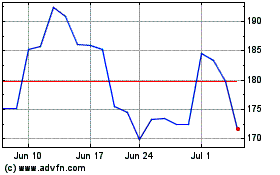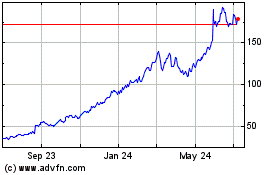Gap Open to Selling on Amazon
May 18 2016 - 11:50AM
Dow Jones News
The rise of Amazon.com Inc. as a new destination for apparel
shoppers hasn't gone unnoticed at the headquarters of Gap Inc.
The struggling apparel chain's chief executive, Art Peck, told
shareholders that Gap is open to selling its merchandise on Amazon
or other third parties in the U.S.
"To not be considering Amazon and others would be in my view
delusional," Mr. Peck said Tuesday in response to an investor's
question at the annual shareholder meeting. "We are always
considering all of our opportunities beyond our traditional mix of
channels and stores."
Amazon has courted apparel brands for years and has started to
lure some department store staples to its site, including Calvin
Klein, Lacoste and Levi Strauss. But Gap is among the chains that
have shunned the online retailer and it has largely focused on
selling jeans, khakis and button-downs through a fleet of more than
3,500 stores and its own websites.
Mr. Peck noted that Amazon now accounts for one-third of all
e-commerce sales in the U.S. and is projected to become the largest
U.S. apparel retailer. "To not acknowledge that and what it means
to our strategy would be to have our head in the sand, and we do
not have our head in the sand," he said.
It's unclear if the two companies are in discussions.
Representatives for Gap and Amazon declined to comment.
Gap has reported four consecutive quarters of declining
same-store sales. The retailer recently warned that sales at stores
open at least a year fell about 5% in the first quarter. The
company, which also owns Banana Republic and Old Navy, is scheduled
to post quarterly results after market close on Thursday.
Gap's business is at risk since sales of basic items "typically
migrate to the lowest priced and most convenient channel,"
according to analysts at Morgan Stanley. They forecast an overall
deceleration of growth in the specialty retail channel over the
next few years as a result of likely share loss to Amazon.
As early as 2014, Amazon was in discussions with about 10
well-known retailers, including Abercrombie & Fitch Co., to
list their products on its online marketplace. The listings would
have directed shoppers to the retailers' own sites rather than
having them make purchases on Amazon.com.
Some retailers are distrustful of how the Internet company uses
customer data. Amazon tests pricing strategies on its marketplace
and has also been known to change pricing on products many times
during a single day. With its trove of data, the Internet giant can
also detect items to sell in competition with retailers.
Selling on Amazon presents a double-edged sword for specialty
retailers with store fleets as large as Gap's. While they can tap
into the online marketplace's growing shopper base, the listings
might also disincentive shoppers from visiting stores, where
brick-and-mortar retailers tend to have better luck converting
traffic to sales.
Gap has used third-party vendors to capture markets outside the
U.S. The company sells its merchandise on TMall, a Chinese
e-commerce marketplace owned by Alibaba Group Holding Ltd., and
Zalando SE, a European website. But Gap operates significantly
fewer stores outside the U.S. As of Jan. 30, Gap had 185
company-owned stores in Europe and 136 in China, constituting a
much smaller footprint than its fleet of more than 2,400 U.S.
stores.
Analysts say Gap's brands have lost their relevance with
millennials and the company's fleet of stores is weighing it down.
Gap's businesses are "simply too large in the new normal where
physical distribution has become a liability and uniformity is no
longer cool," Nomura analyst Simeon Siegel wrote in a research
note.
Gap management spent last year revamping its merchandise
offering after attributing weak performance in previous quarters to
style and quality missteps. Late last year, Mr. Peck rested hopes
for a turnaround on a new product assortment hitting shelves in the
spring.
But the changes haven't translated into sales growth yet. At
Tuesday's meeting, Mr. Peck said that retailers are seeing "almost
unexplainable traffic patterns."
Write to Khadeeja Safdar at khadeeja.safdar@wsj.com
(END) Dow Jones Newswires
May 18, 2016 11:35 ET (15:35 GMT)
Copyright (c) 2016 Dow Jones & Company, Inc.
Abercrombie and Fitch (NYSE:ANF)
Historical Stock Chart
From Mar 2024 to Apr 2024

Abercrombie and Fitch (NYSE:ANF)
Historical Stock Chart
From Apr 2023 to Apr 2024
